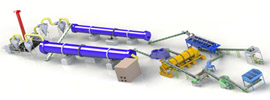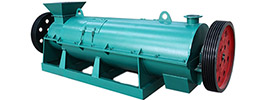I. Physical Characteristics of Chicken Manure Organic Fertilizer
- Moisture Content:
- The moisture content of fermented chicken manure is typically controlled between 30-40%. Some cases mention that the moisture content can be reduced to below 40% after fermentation, which is suitable for pelletizing.
- Before fermentation, the moisture content needs to be adjusted to 50-60% by adding auxiliary materials (such as straw or wood chips).
- Fiber Content:
- Chicken manure has a relatively high fiber content, but it is lower than that of cow manure (chicken manure has an organic matter content of about 25.5%, while cow manure has about 14.5%). Its cohesiveness is poor, so binders or auxiliary materials need to be added to improve pelletizing performance.
- Nutrient Content:
- Chicken manure is rich in nitrogen, phosphorus, and potassium (nitrogen 1.63%, phosphorus 1.54%, potassium 0.85%). It is a hot fertilizer that generates high temperatures during fermentation and requires thorough composting to avoid burning seedlings.
II. Common Pelletizing Methods and Their Adaptability Analysis
1. Disc Granulation
- Principle: The material is rolled into balls by the rotation of a disc, suitable for materials with higher moisture content (50-60%) and better cohesiveness.
- Applicability:
- The moisture content of fermented chicken manure (30-40%) is close to the requirement, but its cohesiveness is insufficient. It is necessary to add auxiliary materials such as straw or wood chips and binders such as humic acid.
- Advantages: Simple equipment, low cost, suitable for large-scale production.
- Case: Yancheng Dafeng Yuanjun Breeding Farm uses pit fermentation and produces 1,100 tons of granular organic fertilizer annually by natural pelletizing or adding a small amount of auxiliary materials, processing 7,500 tons of manure.
2. Drum Granulation
- Principle: Similar to disc granulation, but with a larger processing capacity, suitable for continuous production.
- Applicability:
- The requirements for moisture content and cohesiveness are similar to those of disc granulation. Pre-treatment is required to adjust the moisture content and add binders.
- Advantages: High production efficiency, suitable for large production lines.
3. Extrusion Granulation
- Principle: The material is pressed into pellets by pressure, without the need for binders, but requires low moisture content (10-15%).
- Applicability:
- The moisture content of fermented chicken manure (30-40%) is much higher than required. It needs to be dried first (such as using a dryer), which increases the cost.
- Advantages: High pellet density and strength, suitable for scenarios requiring high strength.
- Case: Some cases mention that extrusion granulation is used for high-value-added products, but supporting drying equipment is required.
4. Roller Granulation
- Principle: Uses roller extrusion to form pellets, suitable for materials with moderate cohesiveness and moisture content of 20-30%.
- Applicability:
- Chicken manure needs to be dried to a lower moisture content, and binders may still be required.
- Advantages: Compact equipment, low energy consumption, suitable for small and medium-sized production lines.
5. Fluidized Bed Granulation
- Principle: Powdered materials are agglomerated into pellets by atomizing liquid binders, with a wide adaptability to moisture content.
- Applicability:
- Chicken manure needs to be pre-treated and dried to a moderate moisture content (30-40%), and liquid binders (such as water) are atomized for forming.
- Advantages: Uniform pellets, strong controllability, suitable for high-precision production.
III. Recommended Pelletizing Methods and Optimization Suggestions
1. Preferred Solution: Disc Granulation + Binder Addition
- Reasons:
- The moisture content of chicken manure (30-40%) is close to the requirement of disc granulation. By adding straw, wood chips (to adjust the C/N ratio) and humic acid (to enhance cohesiveness), the pelletizing performance can be effectively improved.
- Low cost, simple equipment, suitable for large-scale production.
- Process Flow:
Fermented chicken manure → Mixing auxiliary materials → Adjusting moisture content to 50-60% → Disc granulation → Drying → Cooling → Packaging.
2. Alternative Solution: Extrusion Granulation
- Applicable Scenarios:
- When high-strength pellets (such as base fertilizer) are required or the pellet density is strictly required, extrusion granulation can be used, but supporting drying equipment is required to reduce the moisture content to 10-15%.
- Disadvantages: High energy consumption and cost, suitable for small-batch customized production.
3. Fluidized Bed Granulation
- Applicable Scenarios:
- When high uniformity of pellets is required or high-value-added special fertilizers need to be produced, pre-treatment and drying (to 30-40%) can be combined with fluidized bed granulation, and liquid binders are atomized for forming.
- Advantages: High pellet strength and good dispersibility, suitable for precision agriculture needs.
IV.Conclusion
The most suitable pelletizing method for chicken manure organic fertilizer is disc granulation combined with binder addition. It has low cost, strong adaptability, and the pelletizing performance can be optimized by adjusting auxiliary materials. For high-value-added or special demand scenarios, fluidized bed granulation or extrusion granulation can be considered, but pre-treatment steps are required to improve feasibility. The actual production should be comprehensively selected based on the characteristics of raw materials, equipment conditions, and market demand.
 Send us a Email
Send us a Email Wulong Industrial Cluster
Wulong Industrial Cluster Have any question?
Have any question?



















